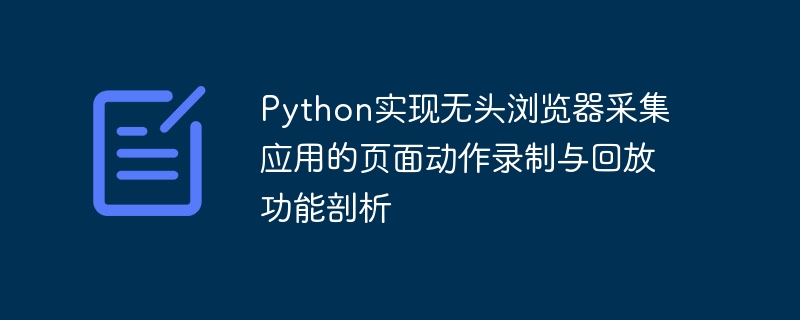

Analysis of page action recording and playback function implemented in Python for headless browser collection application
In the current In the Internet era, web applications are used more and more widely, and the interaction between users and web pages becomes more and more complex. In order to facilitate testing and automated operations, the application of headless browsers is gradually emerging. A headless browser refers to a browser that has no visual interface and can run in the background to perform operations such as page loading, rendering, and JavaScript scripts.
This article will introduce how to use Python to write code to implement the page action recording and playback functions of a headless browser collection application. By recording the user's interaction with the page and then re-executing these behaviors through the playback function, automated testing and operations can be achieved.
In order to realize the collection and playback function of the headless browser, we need the following development environment and tools:
Next, we will follow The following steps are used to implement the page action recording and playback functions of the headless browser.
Step 1: Install Python and Selenium libraries
First, you need to install the Python language environment and Selenium library on the machine. Selenium is a library for automating browser operations and can be installed via the pip command line.
pip install selenium
Step 2: Install the ChromeDriver driver
The Selenium library needs to be used with a specific browser driver. This article uses the Google Chrome browser as an example. First, you need to download the ChromeDriver driver corresponding to the operating system and set it to the system's environment variables.
Step 3: Record page actions
In order to record page actions, we need to start the headless browser and load the target web page. Then, use the methods provided by the Selenium library to add relevant operation steps. For example, click a button, enter text, etc.
from selenium import webdriver # 启动无头浏览器 options = webdriver.ChromeOptions() options.add_argument('--headless') driver = webdriver.Chrome(chrome_options=options) # 加载目标网页 driver.get('http://example.com') # 添加操作步骤 input_element = driver.find_element_by_name('input') input_element.send_keys('Hello, world!') button_element = driver.find_element_by_id('button') button_element.click()
Step 4: Save the recorded action
After the recording is completed, we need to save the recorded action to a file for subsequent playback operations. Objects can be saved and loaded using Python's pickle module.
import pickle # 保存动作到文件 with open('record.pickle', 'wb') as f: pickle.dump(driver.get_log('browser'), f)
Step 5: Perform action playback
When we need to perform action playback, we need to load the saved action file and re-execute it according to the saved operation steps. Objects can be loaded using Python's pickle module.
import pickle # 加载动作文件 with open('record.pickle', 'rb') as f: actions = pickle.load(f) # 重新执行动作 for action in actions: if action['method'] == 'sendKeys': element = driver.find_element_by_id(action['elementId']) element.send_keys(action['args'][0]) elif action['method'] == 'click': element = driver.find_element_by_id(action['elementId']) element.click()
This article introduces how to use Python to write code to implement the page action recording and playback functions of a headless browser collection application. By recording and playing back the user's interaction with the page, automated testing and operations can be achieved.
Using Python and Selenium libraries, we can flexibly implement various complex operation steps. The ChromeDriver driver provides seamless integration with the Chrome browser.
I hope this article can help readers understand and apply the collection and playback functions of headless browsers, and improve work efficiency and code quality.
The above is the detailed content of Analysis of the page action recording and playback function of Python implementation of headless browser collection application. For more information, please follow other related articles on the PHP Chinese website!




